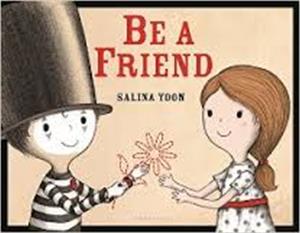Be a Friend. Salina Yoon. 2016. Bloomsbury.
Ages 4–8
Summary
 Be a Friend by Salina Yoon is a simple story of being different from the others around you and how that difference can make you special. The simple text has built in vocabulary opportunities and the soft illustrations add a second dimension to the story.
Be a Friend by Salina Yoon is a simple story of being different from the others around you and how that difference can make you special. The simple text has built in vocabulary opportunities and the soft illustrations add a second dimension to the story.
Dennis is a rather regular boy who enjoyed expressing himself in an unusual way. Even when all the other children responded a certain way, Dennis kept his own methods intact. For example, when other children spoke, Dennis acted out his answer. When other children climbed trees, Dennis “became” a tree. Dennis was called “Mime Boy” because of his choice to act out events. The delightful illustrations will help to explain the art of miming to the students. Even though Dennis is content to be himself, he sometimes would become lonely—feeling invisible and isolated. All these feelings changed when he met Joy, who caught the invisible ball that Dennis kicked. Joy understood Dennis’s emotions and actions and accepted him for who he was. This pairing of friends drew the attention of the other children, who then became interested in the actions of miming and participating in the imaginary scenes Dennis created.
We often have children who move at their own pace or learn differently from the traditional student. Be a Friend takes a look at those differences and celebrates them by encouraging children to stay true to their passions and beliefs even when others don’t understand.
Cross-Curricular Connections
Art (drama), social studies, English, history
Ideas for Classroom Use
What Is a Mime?
This activity builds background knowledge prior to reading the story. Miming is not a common art form practiced today. Students may be unfamiliar with the process of mimes.
Have students brainstorm what they think the word mime means. Encourage and accept all student answers. Discuss prior knowledge and experiences for the word. If know students are familiar with the word, give a quick definition such as “acting things out without talking.” Ask about the game of charades. Create a K-W-L chart of what we know about charades/mimes and what we want to know, leaving a blank for what we learned.
Have students watch a video showing miming such as Mime Act of Balloon Seller by Moinul Haque (D’Source, 2011) to see a mime at work. Discuss the actions as the story is unfolding. With this background information in mind, read Be a Friend and talk about how miming could have made life difficult for Dennis. How does it make Dennis special?
Story Mimes
This activity takes the knowledge learned about mimes and Dennis and incorporates it into familiar stories. After showing the pictures of the different actions both Dennis and the professional mime made, encourage students to try miming on their own. As students feel comfortable, have them present their favorite activity, their favorite story, and so forth.
Encourage students to wait until the mime is over before guessing what story or activity it is showing. As all students finish their attempts at miming, talk about how challenging it could be to tell a story without using verbal words. This can lead to an open discussion about how it can be difficult to be different within a classroom, family, or community. Refer to Dennis and the end of the story in which Joy helped him to connect with the other students. Use this opportunity to encourage all students to make new friends and accept people who may act differently from themselves.
I Like Me…
This activity encourages students to connect life experiences to Be a Friend in a meaningful way. Encourage students to draw themselves being different. When students talk about things they like to do, they may realize that all people have unique talents and abilities and that we can often find others with similar interests.
As a closing activity, have students write, or dictate with a teacher to facilitate and scribe, how they are different and why they like themselves. Create a story wall outside the classroom displaying how students can connect even though they are different. Perhaps two students like dancing, while two others like sports. Other students in the school can view this story wall and begin to have conversations about accepting differences.
Additional Resources
Mime Videos: This page contains 12 videos showing a variety of mimes, including cartoon mimes.
eVoc Strategies: 10 Ways to Use Technology to Build Vocabulary: This article designates 10 ways to use technology to help with vocabulary instruction. Be a Friend offers opportunities for expanding young readers’ vocabulary to include words such as extraordinary, mime, invisible, imaginary, and individuality. Building children’s vocabulary provides a key to comprehension.
Confessions of a Former Bully: This podcast from ReadWriteThink.org touches on both friendships that can be difficult and the topic of bullying. This podcast can be used to further the discussion of Be a Friend and move into the sensitive topic of bullying at the early elementary level.
Kathy Prater is a reading specialist working with students with dyslexia and an instructor with The Learning Center at Mississippi State University in Starkville, MS. She teaches reading and study skills courses to undergraduate students.